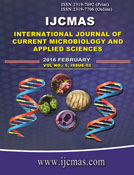


 National Academy of Agricultural Sciences (NAAS)
National Academy of Agricultural Sciences (NAAS)

|
PRINT ISSN : 2319-7692
Online ISSN : 2319-7706 Issues : 12 per year Publisher : Excellent Publishers Email : editorijcmas@gmail.com / submit@ijcmas.com Editor-in-chief: Dr.M.Prakash Index Copernicus ICV 2018: 95.39 NAAS RATING 2020: 5.38 |
Vitamin D holds various roles in body from Calcium homeostasis to modulating immune system. Though, different studies have shown high prevalence of vitamin D deficiency in ill patients, there is lack of one clinical trial that shows the effect of repleting this deficiency and its clinical outcomes. So, the purpose of this study is to compare the mortality of the hospitalized patients in PICU (Pediatrics Intensive Care Unit) in groups with and without the treatment with vitamin D. One-hundred-and-one hospitalized patients in the PICU of children’s hospital in Tabriz during the year (2013-2014) with vitamin D deficiency were considered as the intervention group receiving vitamin D. Also 101 patients were chosen for control group, after equalizing the risk factors by the PRISM III and SOFA scores with intervention group. Calcium and Phosphorus amounts were measured in the very first moments of their hospitalization. Vitamin D was administered 300000 IU intramuscular for the intervention group after measurement of vitamin D level, and the level of vitamin D, duration of hospitalization in hospital and PICU, the duration of being under ventilator and the need for vasopressors agent during hospitalization was measured. The duration of hospitalization in hospital (p<0.001) and PICU (p<0.001), the duration of being under mechanical ventilation (p=0.014) and the need for vasopressors agent (p=0.003) were significantly higher in control group. Also the mortality was significantly higher in intervention group (p<0.001). Vitamin D levels oscillations in expired and discharged patients in intervention group, both were significantly lower in expired patients (p<0.001). This study showed that patients with vitamin D deficiency in PICU have higher rates of mortality in comparison to patients with normal ranges of vitamin D. Also, patients with vitamin D deficiency who expired during their hospitalization did not have sufficient increase in vitamin D levels despite receiving vitamin D supplements.
 |
 |
 |
 |
 |